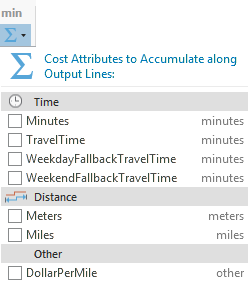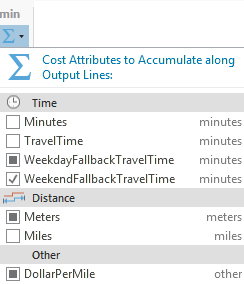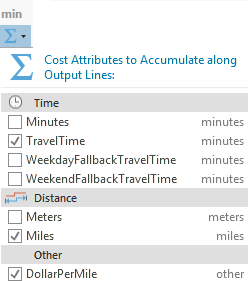This topic describes the closest facility analysis layer's feature classes and analysis properties.
Learn more about the closest facility solver
Facilities feature class
The Facilities feature class stores the network locations that are used as the starting or ending points in closest facility analyses.
When a closest facility analysis layer is created, the Facilities class is empty. It is populated only when network locations are added to it. A minimum of one facility and one incident are necessary to solve the analysis.
Facilities: Input fields
| Input field | Description |
|---|---|
ObjectID | The system-managed ID field. |
Shape | The geometry field indicating the geographic location of the network analysis object. |
Name | The name of the network analysis object. |
Attr_[Cost] (for instance, Attr_DriveTime, where DriveTime is the travel cost) | This property stores an extra cost for the network location. Take the example of finding the three closest fire stations to a fire incident using DriveTime as the impedance. Attr_DriveTime can store the turnout time for the facility. Turnout time is how long it takes a crew to put on the appropriate protective equipment and exit the fire station. |
Cutoff_[Cost] (for instance Cutoff_DriveTime, where DriveTime is the travel cost) | While searching for the closest incident from a facility, Network Analyst can use a cutoff value for the impedance. Any incident beyond the cutoff value is not searched. If the Cutoff_[Cost] is not set for a facility, the analysis uses the default cutoff value specified on the Closest Facility Layer tab for this analysis layer. If a default cutoff value is not set there either, the closest incident is found, regardless of how far it may be. |
Network location fields
|
Together, these properties describe the point on the network where the object is located. |
CurbApproach | The CurbApproach field specifies the direction a vehicle may arrive at and depart from the network location. The shortest path between two points can change depending on the direction of travel permitted when arriving at or departing from a location. There are four choices (their coded values are shown in parentheses):
For closest facility analyses, the No U-turn (3) value functions the same as Either side of vehicle (0). |
Facilities: Input/output fields
| Input/output field | Description |
|---|---|
Status | Indicates the status of the point with respect to its location on the network and the outcome of the analysis. The possible values are the following:
If a facility is not included in the solution because of specified cutoffs or a designated number of facilities to find, the status does not update to Not reached (5). |
Incidents feature class
The Incidents feature class stores the network locations that are used as starting or ending points in closest facility analyses. Whether starting or ending points, incidents are always on the opposite end of a route from the connected facility.
When a closest facility analysis layer is created, the Incidents class is empty. It is populated only when network locations are added to it. A minimum of one facility and one incident are necessary to solve the analysis.
Incidents: Input fields
| Input field | Description |
|---|---|
ObjectID | The system-managed ID field. |
Shape | The geometry field indicating the geographic location of the network analysis object. |
Name | The name of the network analysis object. |
TargetFacilityCount | This property stores the number of facilities that need to be found for the incident. A default value for the number of facilities to find can be set on the Closest Facility Layer tab for this analysis layer. Values specified in the TargetFacilityCount field override that default value. |
Attr_[Cost] (for instance, Attr_DriveTime, where DriveTime is the travel cost) | This property stores an extra cost for the network location. For example, if you're finding the three closest fire stations from a fire incident using DriveTime as impedance, the Attr_DriveTime attribute can store the amount of time spent at the fire incident. This can be the time it takes for firefighters to hook up their equipment and begin fighting the fire. |
Cutoff_[Cost] (for instance Cutoff_DriveTime, where DriveTime is the travel cost) | This cutoff value indicates the farthest network distance to search for a facility. Any incident farther from the facility than the cutoff value is not searched or included in the results. A default value for the cost cutoff can be set on the Closest Facility Layer tab for this analysis layer. Values specified in the Cutoff_[Cost] field override that default value. If the default cutoff value is also not set, the closest facility is found, regardless of how far it may be. |
Network location fields
| Together, these properties describe the point on the network where the object is located. |
CurbApproach | The CurbApproach field specifies the direction a vehicle may arrive at and depart from the network location. The shortest path between two points can change depending on the direction of travel permitted when arriving at or departing from a location. There are four choices (their coded values are shown in parentheses):
For closest facility analyses, the No U-turn (3) value functions the same as Either side of vehicle (0). |
Incidents: Input/output fields
| Input/Output field | Description |
|---|---|
Status | Indicates the status of the point with respect to its location on the network and the outcome of the analysis. The possible values are the following:
|
Routes feature class
The Routes feature class stores the resulting route, or routes, of the analysis. It is an output-only class; the closest facility analysis layer overwrites or deletes any route features while running the analysis.
Routes: Output fields
| Output field | Description |
|---|---|
ObjectID | The system-managed ID field. |
Shape | The geometry field indicating the geographic location of the network analysis object. |
Name | The name of the closest facility route is based on the names of the associated facility and incident. The facility name is first if the direction of travel is from the facility to the incident. For example, Facility 5–Incident 3 indicates the route travels from Facility 5 to Incident 3. The incident name is first if the direction of travel is from the incident to the facility. |
FacilityID | The unique ID of the facility the route visits. |
FacilityRank | The rank of the facility among all facilities found for the associated incident; the closest facility has a rank of 1. |
IncidentCurbApproach | Describes the side of the vehicle the incident is on when arriving at or departing from the incident. A value of 1 means the right side of the vehicle; a value of 2 indicates the left side. |
FacilityCurbApproach | Describes the side of the vehicle the facility is on when arriving at or departing from the facility. A value of 1 means the right side of the vehicle; a value of 2 indicates the left side. |
|
IncidentID | The unique ID of the incident the route visits. |
Total_[Cost] (for instance Total_Minutes, where Minutes is the travel cost) | The cumulative cost of the route between the facility and the incident. This field is generated for the impedance attribute and any accumulated attributes. |
StartTime | The start time of the route, reported as local time at the first stop. |
EndTime | The end time of the route, reported as local time at the last stop. |
StartTimeUTC | The start time of the route in coordinated universal time (UTC). |
EndTimeUTC | The end time of the route in coordinated universal time (UTC). |
Closest facility analysis layer properties
The following subsections list parameters you can set on the analysis layer. They are found on the Closest Facility Layer tab, which is available only if your Closest Facility layer or one of its sublayers is selected in the Contents pane.

Run
After you load input features and set analysis properties, click Run  to solve the closest facility analysis.
to solve the closest facility analysis.
Import Facilities
Import Facilities  is in the Input Data group. Click it to load features from another data source, such as a point feature layer, into the Facilities feature class.
is in the Input Data group. Click it to load features from another data source, such as a point feature layer, into the Facilities feature class.
Import Incidents
Import Incidents  is in the Input Data group. Click it to load features from another data source, such as a point feature layer, into the Incidents feature class.
is in the Input Data group. Click it to load features from another data source, such as a point feature layer, into the Incidents feature class.
Import Barriers
Click Import Point Barriers  , Import Line Barriers
, Import Line Barriers  , or Import Polygon Barriers
, or Import Polygon Barriers  to load features from another data source, such as another feature layer, into one of the barriers feature classes (point barriers, line barriers, or polygon barriers).
to load features from another data source, such as another feature layer, into one of the barriers feature classes (point barriers, line barriers, or polygon barriers).
Create Features
Click the Create Features button  to open the Create Features pane. Select from the available templates to create features in the current map.
to open the Create Features pane. Select from the available templates to create features in the current map.
Mode
The Mode drop-down list allows you to choose a travel mode, which is a group of settings that together model the movement of pedestrians, cars, trucks, or another travel mode. The choices available in the drop-down list depend on the travel modes that are configured on the network data source that the network analysis layer is referencing.
Direction
Your closest facility analysis can accumulate travel time or other cost in the direction away from or toward the facility.
- Away from Facilities—The direction of travel is from the facility to the incident.

- Towards Facilities—The direction of travel is from the incident to the facility.

On a network with one-way restrictions and different travel times based on direction of travel, changing the travel direction can produce different results. The direction you should choose depends on the nature of your analysis. For example, to route the closest fire truck (the facility) to the location of a fire (the incident), the Away from Facilities option is the most appropriate choice. Alternatively, to identify the closest gas station (facility) to your current location, Towards Facilities is a better choice because you need to travel to the facility.
Cutoff
When calculating the least-cost path from an incident to a facility, the Closest Facility solver stops searching for facilities that lie beyond this impedance cutoff. No facilities beyond this limit are found for that incident. The units you use for the cutoff value are shown next to the Mode drop-down list.
Note:
Cutoff assigns default values to origins that do not have numeric values stored in the Cutoff_[Cost] field.
Facilities
You can specify the number of facilities to find per incident by entering a value for Facilities.
Note:
The Facilities value can be overridden on a per-incident basis by specifying an individual value for the TargetFacilityCount property in the incidents sublayer.
Date and Time
The Arrive Depart Date-Time Type drop-down list in the Date and Time group is available when the cost units are time based. From the drop-down list, choose whether a specific time and date value is given to indicate the time that the route or routes depart from their first stop. The primary reason for setting a specific time and date is to solve the analysis using dynamic traffic conditions or public transit schedules; however, to use traffic or public transit in the analysis, the network dataset or route service must include traffic data or public transit.
The options in the drop-down list are as follows:
Not Using Time—Regardless of whether the network data source includes time-based data, the results are based on static travel times—the travel times on a network edge don't vary throughout the day. The Time of Day and Date text boxes are unavailable.
Date & Time—Specify the time as a time of day and calendar date. The Time of Day and Date text boxes are available to provide this information.
Day of Week—Specify a time of day and day of the week. The Time of Day and Date text boxes are available to provide this information. Set the day of the week by typing one of the following values in the Date text box:
- Monday
- Tuesday
- Wednesday
- Thursday
- Friday
- Saturday
- Sunday
Today—Specify a time, and the day is assumed to be the current date. The Time of Day text box is available to provide the time of day, and the Date text box is set to Today and is unavailable so it can't be changed.
Now—When you run the analysis, the time and date are set to the current time and date. This is useful if your network dataset is configured with live traffic data, and the routes are distributed to drivers for implementing immediately after running the analysis. The Time of Day and the Date text boxes are unavailable so they can't be changed.
From the Reference Time Zone drop-down list you can choose which time zone should be used in the analysis. The options are as follows:
- Local Time at Locations
- UTC (Universal Coordinated Time)
Note:
When routing across multiple time zones :
All incidents must be in the same time zone when:
- Specifying a start time and traveling from incident to facility
- Specifying an end time and traveling from facility to incident
All facilities must be in the same time zone when:
- Specifying a start time and traveling from facility to incident
- Specifying an end time and traveling from incident to facility
Time Usage
You can choose the specified date and time to be either the departure time or arrival time.
Time Usage: Departure  —Represents the date and time you want the closest facility routes to start.
—Represents the date and time you want the closest facility routes to start.
Time Usage: Arrival  —Represents the date and time you want the closest facility routes to finish.
—Represents the date and time you want the closest facility routes to finish.
Output Geometry Linear Shape Type
This control allows you to choose how the output displays on the map. The closest facility analysis always solves least-cost paths along the network using the settings you specify. In addition to displaying these true paths along the network on the map, you can also choose to represent the routes on a map using simple straight lines between incidents and facilities or no lines at all.
- No Lines—No output linear shapes are generated.
- Straight Lines—Output simplified geometry as straight lines.
- Along Network—Generate true paths along the network on the map.
Accumulate Cost Attributes
The Accumulate Cost Attributes drop-down menu in the Travel Settings group can be used to configure accumulated cost attributes. The drop-down menu is unavailable if the network data source is a service, the output geometry types do not include lines, or there are no cost attributes. The attributes are grouped by unit domain shown as the group header (for example, Time or Distance). A checked check box indicates that the analysis layer will accumulate the checked attribute during the solve.
When multiple analysis layers of the same layer type are selected, the check box shows a mixed state if all layers do not share the same checked status for one attribute. In the following image, the WeekendFallbackTravelTime attribute is selected for multiple layers, so it has a check mark.
If all selected layers share the checked status for an attribute, the check box shows that state.
Directions
- Output on Solve—Turn on to generate directions upon solve for the current network analysis layer.
- Show Directions
 —When the Output on Solve option is checked, on clicking the Show Directions option, the Directions pane will appear with turn-by-turn directions for each route in the
solution.
—When the Output on Solve option is checked, on clicking the Show Directions option, the Directions pane will appear with turn-by-turn directions for each route in the
solution.
Share as Route Layers
The Route Layers button  in the Share As group allows you to share the results from the analysis as route layers. This button opens the Share as Route Layers geoprocessing tool. Upon successful execution, the results from the analysis are shared as route layer items in the portal.
in the Share As group allows you to share the results from the analysis as route layers. This button opens the Share as Route Layers geoprocessing tool. Upon successful execution, the results from the analysis are shared as route layer items in the portal.